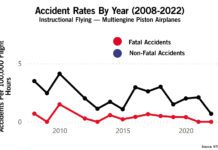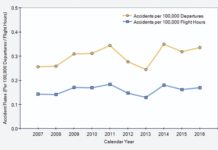August 2, 2013, Eagle Bay, N.Y.
Cub Crafters PA-18-150
The amphibian’s pilot was flying a visual approach to a lake, over mountainous terrain. On an approximate ¾-mile final approach to the lake, she observed a boat near her intended landing area and performed a go-around to circle for another approach. During the go-around and turn, the pilot did not move the throttle lever to full power. About ¼ through the turn, she noticed the airplane was descending and increased engine power. The airplane continued to descend, and she increased engine power a second time. However, one of the airplane’s floats contacted a tree, and the airplane impacted the ground. Examination revealed substantial damage to the wings and the fuselage.
August 3, 2013, Chesterfield, Mo.
Cirrus Design SR22
At 0510 Central time, the airplane was destroyed when it impacted trees and terrain about 0.6 nm west of its departure airport. The airplane was fragmented, and a post-impact fire consumed much of its wings. The private pilot and passenger received fatal injuries. Instrument conditions prevailed; an IFR flight plan was filed.
A witness observed the accident airplane’s navigation lights for about 3 to 5 seconds as it traveled to the west.
The airplane appeared to be traveling at a high rate of speed and in about a 20-degree descent. He saw a fireball as the accident airplane impacted the trees and terrain. He reported that the weather conditions were “very foggy.” He reported that he could only see the accident airplane’s navigation lights due to the fog and light conditions. A special weather surface observation at 0512 included wind from 020 at seven knots, visibility 1¾ miles in mist and an overcast at 400 feet agl.
August 3, 2013, Wild Rose, Wis.
Titan Tornado 1 Experimental
The aircraft was substantially damaged at about 1300 Central time when it impacted trees and terrain after takeoff. The private pilot was seriously injured. Visual conditions prevailed.
According to the FAA, the pilot was having problems with his engine. The pilot had removed and cleaned the spark plugs and was flying the airplane to see if the problem persisted. Shortly after takeoff, the engine lost power. The airplane hit trees and then terrain, resulting in substantial damage to both wings, the empennage and the fuselage.
August 3, 2013, Conway, S.C.
Beech D55 Baron
At about 1250 Eastern time, the airplane was destroyed by post-impact fire/explosion when it impacted a telephone pole and then terrain. The private pilot and two passengers were fatally injured. Visual conditions prevailed.
Witnesses heard the airplane approaching from the southwest and noticed it was extremely low. The airplane then executed a steep right turn, leveled its wings and began to rock side to side. The airplane descended, and its left wing impacted a telephone pole at an estimated height of 30 feet agl. The airplane then spun approximately 180 degrees and impacted terrain, exploding shortly after impact.
August 4, 2013, Alma, Ga.
Beech A36 Bonanza
The airplane was destroyed when it impacted trees and terrain at about 1155 Eastern time. Visual conditions prevailed; an IFR flight plan was filed. The private pilot and passenger were fatally injured.
Witnesses reported hearing a “low flying” airplane and soon after, the sound of impact. Two witnesses reported that the airplane engine was “sputtering” or “skipping.” The airplane initially impacted the tops of trees approximately 60 feet agl and then descended until it impacted the ground. There was no evidence of a fire. All components of the airplane were located in the vicinity of the main wreckage.
August 4, 2013, Tallahassee, Fla.
Mooney M20R Ovation
At about 1210 Eastern time, the airplane was substantially damaged during a precautionary landing. The private pilot and passenger were not injured. Visual conditions prevailed; the airplane was operating on an IFR flight plan.
As the airplane neared 5000 feet msl shortly after takeoff, the pilot reported hearing an “indescribable noise” in his headset. Immediately thereafter, the primary flight display and the multi-function display lost power. The pilot assumed the total loss of electrical power was due to a short circuit, given the abrupt nature with which the power loss occurred. The pilot descended the airplane below the clouds and once in visual conditions, used a portable electronic device to navigate back to the departure airport. During the return flight, the pilot was concerned about a possible fire and smoke in the cockpit and wanted to land the airplane as soon as possible. Upon reaching the airport, the pilot observed the green light gun signal from the tower and landed the airplane on Runway 36 with the landing gear retracted, in order to save the time that would be required to extend it manually.
August 4, 2013, Stanwood, Wash.
Cessna 182P Skylane
The airplane collided with terrain at about 1130 Pacific time, shortly after the pilot aborted a landing attempt. The private pilot and passenger sustained serious injuries; the airplane sustained substantial damage. Visual conditions prevailed.
Several witnesses stated the airplane was landing on Runway 16, which slopes upward at its northern end. The airplane touched down hard after the midfield area and bounced. The pilot then appeared to add full engine power in an attempt to abort the landing. The airplane climbed about 40 to 50 feet and stalled, descending into terrain.
August 5, 2013, Eden Prairie, Minn.
Embraer EMB-505 (Phenom 300)
At 0848 Central time, the airplane was substantially damaged during landing. The two pilots were not injured. Visual conditions prevailed; an IFR flight plan had been filed.
The pilots reported the airplane was on a steep visual approach when they landed long and fast. The pilot flying also reported that after touchdown, he could feel the pulsing of the anti-skid brakes but was unable to stop on the runway surface. The airplane departed the end of the runway and impacted the airport boundary fence coming to rest on a four-lane highway about 1000 feet from the runway. Observed weather included wind from 150 degrees at four knots, six miles visibility in mist, few clouds at 200 feet agl and an overcast at 7000 feet agl.
August 9, 2013, New Haven, Conn.
Rockwell 690B Turbo Commander
The airplane was destroyed at about 1121 Eastern time after impacting two homes while maneuvering for landing. The commercial pilot, one passenger and two people on the ground were fatally injured. Instrument conditions prevailed and an instrument flight rules (IFR) flight plan was filed.
Preliminary information revealed the flight was cleared for the ILS approach to Runway 2, circle to land Runway 20, at 1115:10, At 1115:43, the pilot reported 7.5 nm from the final approach fix. At 1119:26, the pilot reported he was entering a left downwind for Runway 20 and was cleared to land. While circling to Runway 20, ATC asked if he would be able to maintain visual contact with the airport. The pilot stated he was in visual contact now. The last recorded radar target was at 1120:53, about 0.7 miles north of the Runway 20 threshold at 800 feet msl. The airplane came to rest inverted, its forward half inside a home’s basement. The right wing impacted an adjacent house north of the first home. The right engine and propeller impacted the ground in between both homes. A post-accident fire ensued and consumed a majority of the wreckage. Observed weather at 1126 included wind from 170 degrees at 12 knots, gusting to 19 knots, visibility nine miles and an overcast at 900 feet agl.
August 10, 2013, Overgaard, Ariz.
Piper PA-28-180 Cherokee 180
At about 0700 Mountain time, the airplane was substantially damaged during a forced landing following a partial loss of engine power during takeoff. The solo airline transport rated pilot was not injured. Visual conditions prevailed.
The pilot reported the airplane became airborne but did not accelerate as expected. He felt the engine was not producing full power. The pilot adjusted the mixture to full rich and switched fuel tanks with no change in performance. Subsequently, the pilot initiated a forced landing to an open area beyond the departure end of the runway. During the landing roll, the airplane struck a ravine, damaging its left wing and came to rest upright.
August 11, 2013, Ennis, Texas
Beechcraft F33A Bonanza
The airplane was substantially damaged when it impacted trees and terrain at about 1035 Central time. A post-impact fire ensued. The private pilot and passenger were fatally injured. Visual conditions prevailed.
According to several witnesses, the airplane was flying low to the ground. One witness stated its wings rocked back and forth several times as the airplane continued to descend. The airplane banked sharply in one direction and impacted trees and then terrain.
August 11, 2013, Verona, N.Y.
Maule M-5-210C Strata Rocket
The pilot stated after takeoff while en route to the destination airport, he elected to fly to a private airstrip located in rolling farmland. He landed, “but too hard and bounced up…” then touched down on the runway but drifted off the runway into six-to-eight-inch-high grass. He added power to abort the landing but impacted a knoll at the top of a crest of a hill, then continued climbing and proceeded to his destination airport, where he landed uneventfully. While taxiing after landing he noticed the left landing gear was out of position. He further stated there was no pre-impact mechanical failure or malfunction that caused the hard landing.
August 11, 2013, Vienna, Md.
RANS S-12 Experimental
At about 1800 Eastern time, the airplane sustained substantial damage during a forced water landing. The private pilot and student pilot sustained no injuries. Visual conditions prevailed.
The student pilot, who was flying the airplane, stated he and the pilot made two passes around the island to demonstrate the airplane to family members observing from the ground. After completing the second pass, at about 100 feet agl, the student pilot banked to the right, applied engine power and increased the airplane’s pitch attitude, but “something didn’t feel right.” The student pilot applied more power; however, the airplane started to descend. The student pilot turned the airplane’s nose into the wind, applied full power, and continued to increase the pitch attitude, but the airplane would not climb. Continuing to bank to the right, the student pilot then reduced engine power to idle and the airplane subsequently impacted the water.
August 16, 2013, Brooklyn, Iowa
Cessna 206 Stationair
The skydiving airplane sustained minor damage during an in-flight event. The commercial pilot was not injured; however, the passenger was fatally injured. Visual conditions prevailed for the positioning flight.
Both the pilot and passenger were wearing parachutes, per company policy. While at approximately 1500 feet msl, the passenger attempted to move forward in the airplane and sit next to the pilot. The D-ring on the passenger’s parachute was inadvertently activated, deploying the parachute, and egressing the passenger out of the airplane. The pilot circled over the passenger, and observed a deployed canopy from the parachute, then continued to the destination and landed without further incident.
August 16, 2013, Indian Trail, N.C.
Piper PA-22-150 Tri-Pacer
At about 1947 Eastern time, the airplane was substantially damaged during a forced landing following a total loss of engine power. The solo airline transport pilot was not injured. Visual conditions prevailed.
The pilot was about three nm from his destination airport when he experienced a total loss of engine power. The pilot cycled the fuel selector from the left wing tank to the right wing tank and back again. He did not attempt to restart the engine, but did engage the starter to change the propeller position. The pilot identified a field for the forced landing, where the airplane touched down and struck a barbed wire fence before it came to rest. Examination revealed no fuel aboard the airplane.



